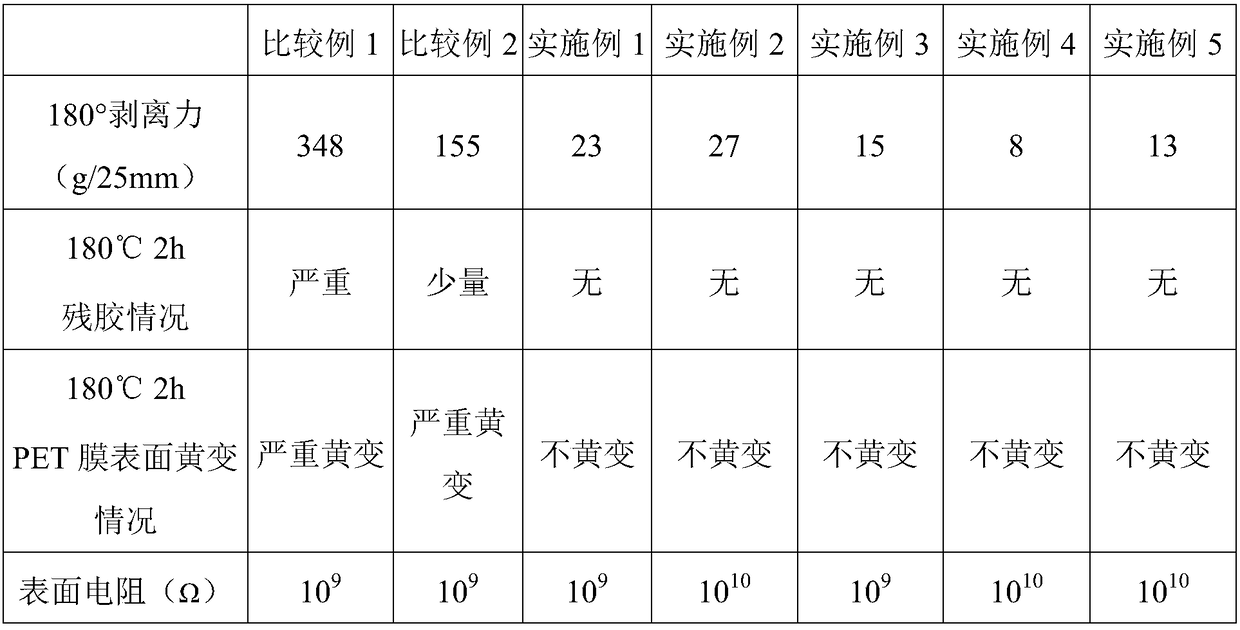An antistatic high-temperature resistant acrylate pressure-sensitive adhesive, and a preparation method and application thereof
An acrylate, high-temperature-resistant technology, applied in the field of pressure-sensitive adhesives, can solve problems such as poor heat resistance and antistatic performance, and achieve the effects of easy peeling, good heat and humidity resistance, and small peeling force
- Summary
- Abstract
- Description
- Claims
- Application Information
AI Technical Summary
Problems solved by technology
Method used
Image
Examples
Embodiment 1
[0036] Raw materials: tert-butyl acrylate 4g, ethyl acetoacetate methacrylate 0.5g, butyl acrylate 27g, acrylic acid 0.5g, 4-hydroxybutyl acrylate 0.5g, glycidyl methacrylate 1g, piperidine methacrylate 1 g of ethanol ester, 0.5 g of N-phenylmaleimide, 0.105 g of initiator (AIBN), 60 g of ethyl acetate, and 5 g of methanol.
[0037] Preparation:
[0038] 1) tert-butyl acrylate, ethyl acetoacetate methacrylate, butyl acrylate, acrylic acid, 4-hydroxybutyl acrylate, glycidyl methacrylate, piperidine ethyl methacrylate, N-phenyl horse Imide was mixed to obtain a monomer mixture, and ethyl acetate and methanol were mixed to obtain a mixed solvent. Take 21g of the above-mentioned monomer mixture and 29.3g of the mixed solvent, pour it into a four-neck flask equipped with mechanical stirring, a thermometer, and a condenser tube and heat it to 66°C, then pour 0.032g of the initiator AIBN into the reaction flask. Start timing after reflux, and keep warm for 0.5h.
[0039] 2) After ...
Embodiment 2
[0044] Raw materials: tert-butyl acrylate 4g, ethyl acetoacetate methacrylate 0.5g, butyl acrylate 24.5g, acrylic acid 1g, 4-hydroxybutyl acrylate 1g, glycidyl methacrylate 2g, piperidine ethanol methacrylate 1.5 g of ester, 0.5 g of N-phenylmaleimide, 0.105 g of initiator (AIBN), 60 g of ethyl acetate and 5 g of methanol.
[0045] Preparation:
[0046]1) tert-butyl acrylate, ethyl acetoacetate methacrylate, butyl acrylate, acrylic acid, 4-hydroxybutyl acrylate, glycidyl methacrylate, piperidine ethyl methacrylate, N-phenyl horse Imide was mixed to obtain a monomer mixture, and ethyl acetate and methanol were mixed to obtain a mixed solvent. Take 21g of the above-mentioned monomer mixture and 29.3g of the mixed solvent, pour it into a four-neck flask equipped with mechanical stirring, a thermometer, and a condenser tube and heat it to 66°C, then pour 0.032g of the initiator AIBN into the reaction flask. Start timing after reflux, and keep warm for 0.5h.
[0047] 2) After th...
Embodiment 3
[0052] Raw materials: tert-butyl acrylate 6g, ethyl acetoacetate methacrylate 0.5g, butyl acrylate 18.5g, acrylic acid 2g, 4-hydroxybutyl acrylate 2g, glycidyl methacrylate 4g, piperidine ethanol methacrylate 1.5 g of ester, 0.5 g of N-phenylmaleimide, 0.105 g of initiator (AIBN), 60 g of ethyl acetate and 5 g of methanol.
[0053] Preparation:
[0054] 1) tert-butyl acrylate, ethyl acetoacetate methacrylate, butyl acrylate, acrylic acid, 4-hydroxybutyl acrylate, glycidyl methacrylate, piperidine ethyl methacrylate, N-phenyl horse Imide was mixed to obtain a monomer mixture, and ethyl acetate and methanol were mixed to obtain a mixed solvent. Take 21g of the above-mentioned monomer mixture and 29.3g of the mixed solvent, pour it into a four-neck flask equipped with mechanical stirring, a thermometer, and a condenser tube and heat it to 66°C, then pour 0.032g of the initiator AIBN into the reaction flask. Start timing after reflux, and keep warm for 0.5h.
[0055] 2) After t...
PUM
 Login to View More
Login to View More Abstract
Description
Claims
Application Information
 Login to View More
Login to View More - R&D
- Intellectual Property
- Life Sciences
- Materials
- Tech Scout
- Unparalleled Data Quality
- Higher Quality Content
- 60% Fewer Hallucinations
Browse by: Latest US Patents, China's latest patents, Technical Efficacy Thesaurus, Application Domain, Technology Topic, Popular Technical Reports.
© 2025 PatSnap. All rights reserved.Legal|Privacy policy|Modern Slavery Act Transparency Statement|Sitemap|About US| Contact US: help@patsnap.com

